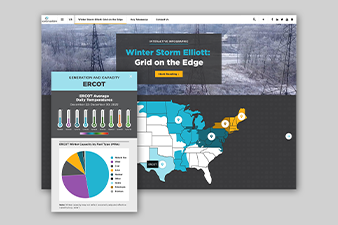
Federal Energy Regulatory Commission (FERC) Commissioner Christie recently noted: “The United States is heading for a reliability crisis…. Dispatchable generating resources are retiring far too quickly and in quantities that threaten our ability to keep the lights on.”
Complicating matters are changing weather patterns – hot spells and cold snaps – and demands on the grid from both distributed energy resources and increasing variable wind and solar resources.
These trends and recent events has led the electric industry to re-examine the issue of resource adequacy.
Old Paradigm, New Considerations
Resource adequacy (or RA) is “the ability of the electricity system to supply the aggregate electric power and energy requirements of the electricity consumers at all times, taking into account scheduled and expected unscheduled outages of system components.”
The historical approach to resource adequacy has been assurance of sufficient power supply at the time of peak demand, with target level of system reliability allowing for risk that power generation is short of demand one day (24 hours) in ten years (or 2.4 hours per year).
Historically, large, dispatchable central station generation and one-way flows from those units to customers made RA relatively straightforward. However, the current environment has introduced new considerations for adequacy:
- Changing weather patterns: Weather variability, including widespread and prolonged drought, cold snaps, and heat waves. Weather-related outages increased 78% from 2000-2010 to 2010-2020, affecting both dispatchable and variable resources.
- Changing load characteristics: Load levels and seasonal and hourly shapes are changing due to electrification and changing weather patterns.
- Electric-gas interdependence: With natural gas fueling a growing percentage of generation (about 39% in 2022), greater winter power demand for gas is competing at key hours with other end-use demand and gas infrastructure is not expanding to accommodate it.
- Inverter-based and variable resources: More non-dispatchable resources are being added to the grid, with those resources subject to stochastic availability and seasonal and diurnal variations.
- Demand-side resources: Investment is growing in demand-side flexibility and distributed resources to both reduce demand and, in some cases, serve as bulk power resources.
- A wild card is the impact of the Environmental Protection Administration’s (EPA) recently proposed fossil generation greenhouse gas emissions rule. EPA’s analysis shows that, by 2040, all coal-fired generation is effectively retired. However, its reliability analysis uses a traditional availability at peak approach. This will be subject to much debate as stakeholders weigh in on the rule.
Next Level Resource Adequacy Planning
Utilities, resource planners, and reliability coordinators are now considering new approaches to planning that will consider extreme scenarios, multi-hour and multi-day events, and higher variability of both demand levels and resource performance (including potential fuel disruption). North American Electric Reliability Corporation (NERC) has recommended conducting all-hours analyses that not only consider the ability to meet peak demand but also energy adequacy over all hours, which NERC has identified as a challenge with a changing resource mix.
Thought leaders are examining new approaches to account for changing conditions and resources. Some have urged using multiple adequacy metrics in addition to loss-of-load expectation to account for different uses (e.g., magnitude of tail-risk events) and time frames. Others have noted that, with weather-influenced correlated events affecting RA and different types of shortfalls (size, frequency, and duration), more probabilistic and time-granular simulations are needed.
Other Actions and Issues
Pending a regime change in planning and modeling, system operators and planners are testing other more discrete approaches for near-term RA.
Resource pooling is one approach that can aid in RA, particularly for regions with diverse resources. The Western Resource Adequacy Program is a voluntary region-wide approach that affords resource pooling and transfers in tight conditions where there is sufficient transmission capacity.
The mixed performance of both dispatchable and variable resources at times of system stress has led several regions to revisit how and how much capacity is credited to them (also termed equivalent load-carrying capability).
RTO/ISO markets have or are contemplating controllable flexibility and ramping products or requirements and related compensation to respond to significant, short duration needs.
FERC and NERC are also weighing in. FERC staff conducted a workshop in late 2022 focused on issues related to increasing minimum interregional transmission transfer capacity, which could aid resource sharing. NERC is establishing a standard requiring transmission system planning for extreme heat and cold weather over wide geographical areas, including studying the impact of concurrent failures of bulk power system generation and transmission equipment.
Lessons for Utilities
Given these trends, resource planners enhance their RA planning based upon iterative looks at potential composition of future resources and weather and climate conditions. This will mean using more probabilistic and less deterministic analysis. Demand forecasting will be increasingly critical and should factor in a wider range of uncertainty.
Also, as load becomes more fungible, demand-side measures are emerging as a valuable resource and will be a more significant part of the RA portfolio.
Finally, RA and reliability more generally come at a cost. Utilities will need to frame for regulators and customers the economics of RA – in particular, the trade-offs of resource cost and performance.
Anticipate more activity on this topic in the coming months and years as the clean energy transition evolves.



